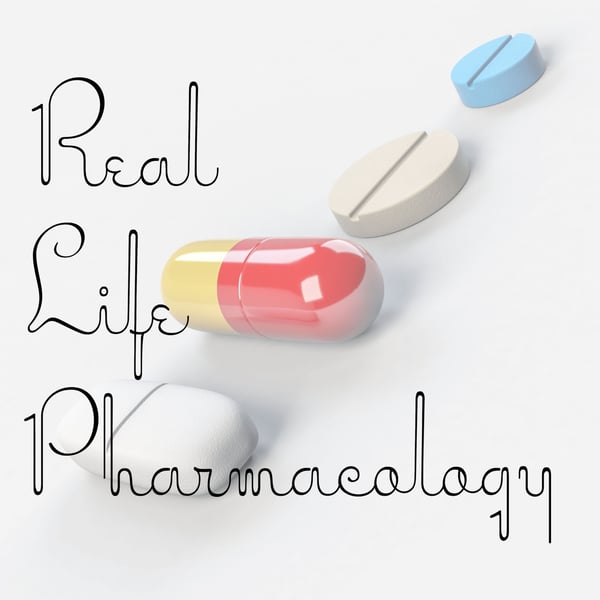Atorvastatin Pharmacology
Real Life Pharmacology - Pharmacology Education for Health Care Professionals
Eric Christianson, PharmD; Pharmacology Expert and Clinical Pharmacist
5 • 716 Ratings
🗓️ 30 September 2021
⏱️ 16 minutes
🧾️ Download transcript
Summary
Atorvastatin (Lipitor) is an HMG-CoA reductase inhibitor, the rate-limiting step in the production of cholesterol. It is used to prevent atherosclerotic cardiovascular diseases by decreasing cholesterol.
Atorvastatin is more lipophilic in comparison to other statins such as rosuvastatin. If a patient does not tolerate a statin, switching from a lipophilic to a hydrophilic or vice versa may decrease the chances of those side effects reoccurring.
It can be a high-intensity statin depending on the dose. 10-20mg is considered moderate and 40-80mg is classified as high intensity. Not all statins can reach high-intensity doses, which is why atorvastatin is so commonly used.
The FDA as of July 2021, has requested to remove the contraindication of pregnancy from the prescribing information. Here’s more information on that specific change and why it was requested. I’d encourage you to read it.
Atorvastatin is commonly found to have adherence issues so it should be taken whenever it is going to be best remembered by the patient.
Common adverse effects include myopathy, muscle pain, and soreness. Many elderly patients can be overlooked when they experience aches and pains, so it is important to take their medications into consideration. There are rare risks of liver injury and rhabdomyolysis. CPK and LFTs do not need to be regularly monitored if no symptoms are present.
Remind patients that their cholesterol will not be lowered right away. They will usually have their levels rechecked in 3-6 months.
Drugs that increase rhabdomyolysis risk when used concurrently include fibrates, red yeast rice, niacin, daptomycin. Monitor these patients closely for symptoms of muscle pain. Can also monitor CPK and decrease the dose of the statin in these patients. 3A4 interactions can increase the concentration of statins. These include clarithromycin, grapefruit juice, amiodarone, amantadine, and verapamil. 3A4 inducers can decrease the concentration of statins. These include St. John’s Wort and carbamazepine.
Transcript
Click on a timestamp to play from that location
| 0:00.0 | Hey all, welcome back to the Real Life Pharmacology podcast. I'm your host, pharmacist, Derek Christensen. |
| 0:06.3 | Thank you so much for listening today. The drug of the day today is going to be a torvastatin. |
| 0:11.8 | But before I get to that, obviously, go check out real-life pharmacology.com. Go subscribe and follow there and get your free 31 page PDF. That's a great little study guide |
| 0:23.4 | refresher on the top 200 drugs. And I pulled out some of the most important things that are |
| 0:29.0 | usually tested on and or things that you're going to actually see in real life with regards |
| 0:34.9 | to those top 200 drugs. So again, go get that at real life pharmacology.com, absolutely free. |
| 0:40.7 | Simply just an email for subscribing. |
| 0:43.7 | And we'll get you out emails when there's new podcasts |
| 0:47.0 | and or new content available for you there. |
| 0:50.1 | So go check that out, real Life Pharmacology.com. |
| 0:55.0 | All right. |
| 0:55.3 | So getting into the drug of the day today, a torvastatin brand name is Lipitor. |
| 1:00.2 | And this has been one of the heavy hitters all throughout my career. |
| 1:05.3 | This drug is used every day. |
| 1:08.8 | I pretty much see this medication used. It is a statin, of course, and it lowers cholesterol |
| 1:17.1 | as its primary use there. Mechanistically, I'm not going to spend a ton of time on it, but if you go |
| 1:24.5 | back, I did do statins early on as a general class. |
| 1:28.3 | So you can listen to that if you want a little bit more details on the mechanism of action. |
| 1:34.3 | But it is an HMG-CoA reductase inhibitor and this is the rate limiting step, basically, in the production of cholesterol is the kind of quickest way I can sum it up there. |
| 1:48.0 | Uses we're going to prevent, reduce the risk of atherosclerotic cardiovascular disease, |
| 1:55.0 | which is done by decreasing cholesterol. |
| 1:58.0 | And I wanted to focus a little bit more so on you know what makes a |
... |
Please login to see the full transcript.
Disclaimer: The podcast and artwork embedded on this page are from Eric Christianson, PharmD; Pharmacology Expert and Clinical Pharmacist, and are the property of its owner and not affiliated with or endorsed by Tapesearch.
Generated transcripts are the property of Eric Christianson, PharmD; Pharmacology Expert and Clinical Pharmacist and are distributed freely under the Fair Use doctrine. Transcripts generated by Tapesearch are not guaranteed to be accurate.
Copyright © Tapesearch 2025.

